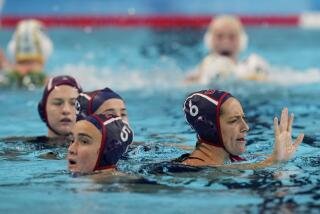AMERICA’S CUP ’92 : Finances Halve the Challenger Field
- Share via
SAN DIEGO — Spain, Sweden and two crews from Australia were ushered out of the America’s Cup with stiff upper lips and champagne Sunday but, in truth, their bubbles burst long ago.
To have or have not makes all the difference in the new economics of the event.
Spirit of Australia skipper Peter Gilmour said, “The issue is the money, and what it takes to participate is quite unbelievable. There is going to be quite a lot of discussion about where the Cup is going from here.”
Principals of the new International America’s Cup Class will meet this week, and most seem to be leaning toward restricting costs to allow broader participation and more level competition.
“It’s certainly sad from our point of view, Australia having been involved in the America’s Cup for parts of four decades, to be one of the teams that isn’t participating in the final,” Gilmour said. “We take it pretty hard . . . take it on the chin. But it wouldn’t be a surprise if you see us back again.”
But perhaps not soon. Hugh Treharne, skipper of the other Aussie boat, Challenge Australia, was terse.
“There’s a really bad recession in Australia at this time,” Treharne said. “Until we get out of that I don’t think there’s any chance . . .”
It’s no coincidence that the four surviving semifinalists built 15 boats among them, at about $5 million apiece, the other four only five. Gilmour made the point that a proper research and development program requires at least three.
And it was no surprise that none of the bottom four ever beat any of the top four, and that the pattern held with all four races Sunday.
With westerly winds building from 6 to 12 knots, Nippon (18-3, 82 points) sailed rings around Challenge Australia (1-20, 8), which has been dubbed a “dog” by its own owner, Syd Fischer--and, symbolically, finished its final race with a broken bowsprit.
New Zealand (18-3, 74), with skipper Rod Davis taking a day off as Russell Coutts took the helm, cruised past Sweden’s Tre Kronor (3-18, 13) by 6:11.
Ville de Paris (14-7, 61) fought off Espana ’92 (7-14, 30) by 1:38, and Il Moro di Venezia (15-6, 69) just kept Spirit of Australia (7-14, 27) at arm’s length by 1:15.
Challenge Australia’s broken bowsprit--a copy of New Zealand’s novel, if controversial, innovation--was almost a tragedy.
Treharne said, “The bobstay (the cable holding the tip of the appendage down by the lower edge of the bow) ripped out of the bowsprit. At the time the (spinnaker) pole was off the mast, completing the jibe sequence, and (when) the bowsprit took off it took the downhaul (line) with it and shot the pole back like a javelin.
“Luckily, it went straight in the middle of the boat between all the crew. It glanced off one of them and knocked him over . . . knocked the wind out of him and bruised him a bit. If it had hit him square on it would have gone through him like a nail.”
Espana ’92 managed to lend a happy ending to its quincentennial celebration of Columbus’ voyage. Down the final leg to the finish the Spaniards flew a white spinnaker declaring: “We America . . . 1492-1992.”
Below it was signed by the crew in large letters, with the final notation: “See you in 2092.”
At the dock, skipper Pedro Campos and most of the crew took a traditional dunking, just like winners.
Gilmour said Spirit’s campaign, conceived on a shoestring by Iain Murray, showed flashes of promise at times, especially this past week, but “too little, too late.”
Sweden’s Gunnar Krantz’s sense of humor remained intact following what he called “probably the shortest America’s Cup challenge ever--arrive late and leave early.”
The Swedes showed up in time to sail their boat only three times before they had to race it.
“It’s been great fun,” Treharne said at the final press conference, nodding to his right. “Along this table amongst the four semifinalists we feel certainly will be the winner of the America’s Cup. The high standards you have set is something the Americans must be really nervous about.”
Davis responded, “While we have four boats continuing, equally important are the four boats that competed early on and provided a variety of ideas and technology.
“I’ve been on the receiving end (in five previous Cups). It’s a very hard thing to go through. But without those bottom four boats, a lot of technology and a lot of good ideas would never have come to the challengers.”
The troubles are over for those four. No more keel changes. No more overnight shifts sewing new sails. No more chainsaw massacres of their boats.
For the survivors, the pressure goes up a notch. Until the semifinals start March 29, powerhouse Il Moro di Venezia in particular will be looking for the speed it misplaced between the second and third rounds.
“We’re not exactly where we want to be for the next round,” skipper Paul Cayard said. “But the people who survive are the ones who can figure out a way to overcome.”


